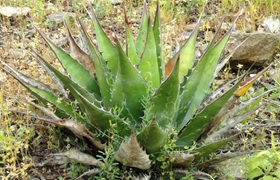
General Germination Guide for Agave Seeds
The following description is a material containing suggestions to assist in achieving successful germination. The guide is primarily based on the description of germination process(es) performed by others and personal experiences.
If you also have experience in germinating agave seeds, feel free to share your comments at the bottom of the page!
IMPORTANT: The following description is a material containing suggestions to assist in achieving successful germination. The guide is primarily based on the description of germination process(es) performed by others and personal experiences. Species we handle generally have a harder time germinating in environments different from their natural habitat. We always recommend researching the specific species' natural habitat, methods, and techniques for breaking dormancy*. Additionally, we advise gathering information from multiple sources.
1. Preparation of Seeds
The first and most important step is to soak the seeds in clean, room-temperature water for at least 24 hours. With such a short soaking period, there is no need to change the water unless it becomes slimy or excessively discolored. Around the halfway point of the 24 hours, it's a good idea to check on them. If you soak them for more than 24 hours, make sure to change the water accordingly. The soaking process softens the seed coat, facilitating easier and faster germination. It's crucial to plant the seeds immediately after soaking.
Note: the water sinking test for seeds is not always a reliable method for predicting germination capability. The most effective way to determine if a seed can germinate is to create the conditions for germination and monitor the process closely.
2. Planting Medium
The materials used for germinating seeds should have good water drainage while also possessing some moisture-retaining capacity. The alternating conditions of periodic dryness and humidity can negatively impact the seeds during germination. A widely successful mixture is a 1:1 ratio of general potting soil and perlite, which has been applied successfully worldwide, and we also recommend its use. Fill a seed tray with the prepared soil mixture, then water it thoroughly (with stagnant tap water or rainwater). Allow excess water to drain from the container before planting. You can also use peat pellets, coconut coir, or a mixture of sand/perlite, potting soil, and coconut coir in appropriate proportions as a planting medium. Whatever you choose, good water drainage and loose structure are crucial!
3. Placement of Seeds
Place the soaked seeds in the prepared bed. Press them into the bedding in such a way that there is never more than 0.5-1 cm of "soil" above the seeds. It's essential not to plant the seeds too deep because proper oxygen supply is crucial for germination, and most agave seeds require light for sprouting. If planted too deep, the seeds/seedlings may struggle to emerge at the soil surface, reducing the chances of successful germination. If you are planting multiple seeds in a container, leave at least 2-3 cm of space between the seeds! We recommend sowing the seeds in a container where the freshly sprouted seedlings can spend their first few months. Based on our experience, it's not advisable to transplant agave seedlings immediately after germination.
4. Temperature
Achieving the proper temperature is crucial for the germination of seeds. For agave seeds, the ideal temperature range is approximately 22-27 °C.
5. Light
Place the seeds in a shaded or partially shaded area until germination. It's important that they receive diffused light and not direct sunlight.
6. Moisture
Seeds require a constant and consistent level of moisture during the critical stages of germination. Alternating between extremely wet and dry periods during germination can generally have adverse effects on the desired results. If you don't have an automatic irrigation system, covering the containers with transparent plastic or glass may be necessary to maintain the appropriate soil moisture. The planting medium should not dry out during germination, but excessive watering can be equally harmful as it may lead to seed rot.
7. Germination Time and Rate
The germination rate, uniformity of germination (timing), and the overall success of the germination process can vary significantly, expressed as a percentage, depending on the species, among seeds from different plants of the same species, and even among seeds collected from the same plant in different years. For agaves, the germination period is typically two to three weeks, but some seeds may sprout as early as four days after planting.
8. First Transplantation Following Germination
The seedlings can be transplanted once they have developed 2-3 leaves. Ideally, transplanting should be done during the warmer months of the year when root growth is faster. It is recommended that the first transplanting not be directly into the open ground but into larger, separate containers. Make sure to transplant the plants into high-quality, well-draining soil!
9. Patience
It's important to be patient during the germination process and regularly observe the seeds. Agaves are not fast-growing plants; however, with proper care, they can provide long-term joy for those interested in a tropical/exotic atmosphere.
*Dormancy refers to a state in which a seed is temporarily unable to germinate, even when the conditions for growth are present. This mechanism is a survival strategy in plants, helping them avoid growth or development during unfavorable periods.


